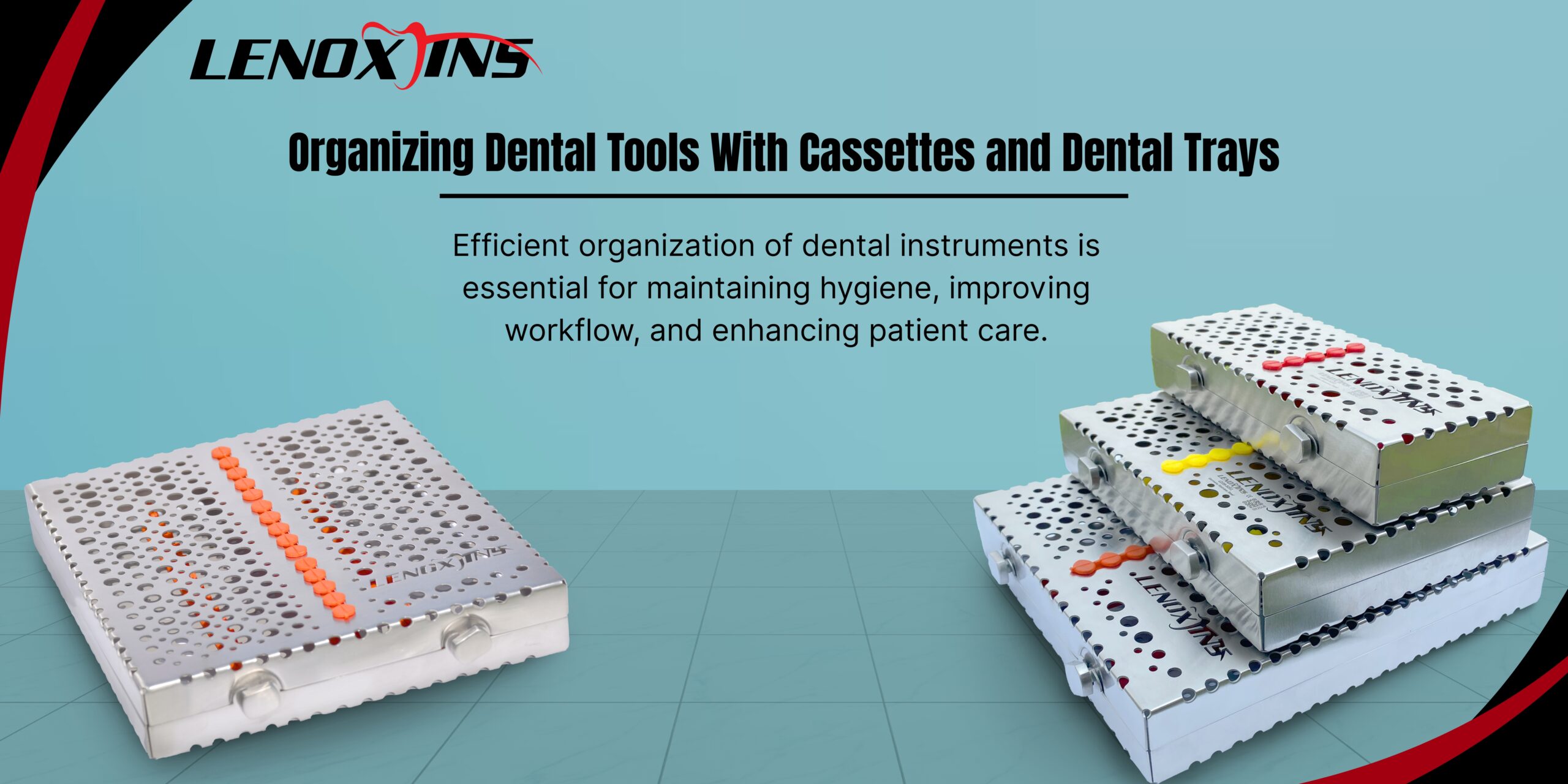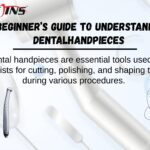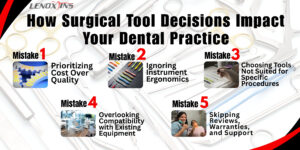Instrument Cassettes vs Trays: Organizing Dental Tools With Cassettes and Dental Trays
- 104
- June 5, 2025
- Dental Instruments

Instrument Cassettes vs Trays: Organizing Dental Tools With Cassettes and Dental Trays
In dental practices, organization and sterilization are critical for delivering high-quality patient care while ensuring safety. The efficient management of dental tools, such as precision dental tools, can influence treatment outcomes, reduce cross-contamination risks, and improve workflow efficiency. With increasingly complex procedures—from endodontics to implant placements—dental professionals seek systems that combine ease of use with high standards of sterilization. For those looking to Shop The Best Dental Tools, selecting instruments that offer both reliability and ease of maintenance is essential. Instrument Cassettes and Dental Trays are two prominent solutions that organize instruments and support stringent autoclave protocols. However, differences in design, material, durability, and cost determine which method best suits a practice’s needs.
This article examines why dental tool organization matters, defines the key components of instrument cassettes and dental trays, and compares them regarding workflow efficiency, infection control, and cost-effectiveness. It also discusses sterilization and maintenance concerns, the reduction of practitioner stress and errors, and provides guidance on choosing the appropriate tool organization system. Optimal organization is not merely about storage but about enhancing clinical efficiency and ensuring patient safety.
Why Dental Tool Organization Matters
Maintaining good dental tool organization is essential for clinical efficiency, infection control, and operator comfort. Organized instruments lead to smoother workflows and reduce the chances of errors during procedures.
Impacts on Clinical Efficiency
Effective organization helps dental teams locate instruments quickly, reducing downtime between procedures. Streamlined instrument management can enhance treatment times, support faster turnover during busy periods, and allow more attention to treatment precision. Standardized tool placement creates a uniform working environment that minimizes confusion and improves team coordination during complex procedures.
Enhancing Infection Control
A well-organized instrument system minimizes cross-contamination risks. Systematically arranged dental tools are easier to inspect and maintain, ensuring that each instrument is sterilized properly. Instruments in dedicated cassettes or trays can be reliably traced through the sterilization cycle, which is vital for complying with hygiene protocols and regulatory requirements. This organized approach reinforces staff accountability and reduces the chance of mishandling.
Reducing Practitioner Stress and Errors
A cluttered work environment can increase stress and errors during procedures. Organized cassettes or trays reduce cognitive overload by providing a predictable layout. Clear visibility and consistent placement of instruments boost the operating team’s confidence and decrease the likelihood of mistakes, allowing dental professionals to focus on precise, high-quality patient care.
What Are Instrument Cassettes and Trays?
Instrument cassettes and dental trays are specialized systems for storing and organizing dental instruments during and after procedures. Their design is critical for efficient sterilization and streamlined workflow in dental clinics.
Defining Instrument Cassettes
Instrument cassettes are constructed from high-grade stainless steel or durable thermoplastics built to withstand repeated autoclave cycles. They incorporate individual compartments and locking mechanisms to hold instruments securely during transport and sterilization. Their compact design maximizes sterilization space while protecting sensitive instruments. Cassettes are compatible with various sterilization protocols and offer long-term durability with reduced instrument misplacement.
Defining Dental Trays
Dental trays are more open systems made of stainless steel or heat-resistant plastics. They serve as carriers for loose instruments during procedures, often featuring raised edges or grooves to keep tools organized and demarcated between used and unused instruments. Trays are favored in situations where instruments must be frequently rearranged or remain readily visible to the dental team. Their versatility allows customization to meet specific procedural needs.
Materials and Build Differences
Both cassettes and trays are made with materials chosen for corrosion resistance and the ability to withstand high autoclave temperatures. Stainless steel is common due to its strength and ease of cleaning. Some practices may also use high-performance thermoplastics or silicon components to reduce weight. Cassettes offer a closed, compartmentalized design with secure closures while trays provide an open layout that is easily customized. These differences affect longevity, ease of maintenance, and overall adaptability in clinical settings.
Comparing Cassettes and Trays in Daily Dental Practice
Dental practices weigh the benefits and limitations of instrument cassettes versus trays in terms of setup time, infection control, and staff training. While both systems are essential for safe and efficient operations, their differences can determine which is ideally suited for a given clinical environment.
Setup and Workflow Speed
Instrument cassettes are designed for rapid setup; every instrument has a predetermined slot that simplifies preparation before procedures. This structured system minimizes setup time, allowing treatments to begin sooner. In contrast, dental trays may require more deliberate organization, especially if multiple trays are needed to segregate instruments. Although trays offer flexibility with adjustable configurations, the extra time needed for rearrangement can slow workflow in high-volume practices. For busy clinical settings, a well-organized cassette system often provides a faster turnaround.
Cross-Contamination Risk
Cassettes, being sealed systems, offer a significant advantage in reducing cross-contamination. Each instrument is secured in its own compartment, limiting exposure to contaminants during handling and transport. Dental trays, even when designed with raised edges or dedicated sections, expose instruments to environmental factors that can increase contamination risk. Consequently, practices with high sterility requirements often prefer cassettes despite less configurability.
Staff Training and Standardization
Using a uniform cassette system can improve staff performance and consistency. With a predictable layout, dental assistants can be quickly trained to assemble, sterilize, and manage instruments with minimal error. While trays offer customizable configurations, they may require more detailed training and periodic re-training to ensure consistent organization. In environments where many practitioners interact with the same tools, the simplicity and reliability of cassettes help reduce variability.
Sterilization and Maintenance
Proper sterilization and maintenance are paramount for dental instruments. Both cassettes and trays contribute to maintaining sterility, but they differ in cleaning protocols and ease of maintenance.
How Instrument Cassettes Simplify Sterilization
Cassettes streamline sterilization by offering an enclosed system that can be loaded directly into autoclaves without unpacking instruments. Their compartmentalized design allows sterilizing agents to reach every tool evenly while limiting post-sterilization contamination. With fewer handling steps, cassettes reduce errors and instrument loss, leading to reliable sterilization and enhanced clinical safety.
Sterilizing Dental Trays and Loose Instruments
Dental trays require careful management during sterilization due to their open design. Instruments in trays are often pre-sorted before autoclave use, which adds a step and increases the potential for errors or cross-contamination. Although modern trays have improved features for autoclave compatibility, the risk of uneven sterilization remains. Practices using trays must adhere to rigorous cleaning protocols and invest in thorough staff training to manage these challenges effectively.
Durability and Reusability
Instrument cassettes are built to endure repeated sterilization cycles, offering long-term durability and reusability. Their robust design minimizes corrosion and structural failure, yielding long-term cost savings. In contrast, dental trays, while generally durable, may experience faster wear and tear due to frequent handling and exposure. Damage such as bent edges can compromise their functionality, making cassettes a preferred option in practices that prioritize longevity and low maintenance.
Cost-Benefit Analysis
Evaluating the financial aspects of instrument cassettes versus dental trays is important for balancing budget constraints with clinical efficiency.
Upfront Costs vs Long-Term ROI
While instrument cassettes may involve a higher initial investment than trays, their long-term benefits often justify the cost. Their durability, reduced need for replacement, and time savings during sterilization contribute to better overall value. Although trays may have a lower purchase price, increased maintenance and potential instrument damage can diminish short-term savings, making cassettes more cost-effective over time.
Reducing Instrument Damage and Loss
Cassettes’ secure compartments prevent damage and loss of instruments during routine handling and sterilization. This protective design is particularly valuable for expensive or delicate instruments used in orthodontics or endodontics. By minimizing instrument damage and misplacement, practices lower repair and replacement costs while maintaining high standards of patient care.
Staff Time Savings
The intuitive design of instrument cassettes reduces the setup and sterilization time required by dental assistants, translating into improved productivity. In contrast, the flexibility of trays can require extra time for organization, especially in high-volume settings. Time savings with cassettes not only streamline operations but also contribute to better financial performance for busy practices.
Choosing the Right Tool for Your Practice
Selecting between instrument cassettes and dental trays depends on factors unique to each dental practice, including size, procedure types, and product reliability.
Practice Size and Workflow
Larger practices with high patient volumes and simultaneous procedures benefit from the standardized, compartmentalized design of instrument cassettes. They enable rapid turnover and reduce preparation times. Smaller practices, while valuing efficiency, might appreciate the customizable nature of dental trays if instrument configurations vary by procedure. Regardless, both systems must balance flexibility with consistent infection control.
Types of Procedures Performed
Complex restorative or surgical procedures often require the stable, secure containment of sensitive instruments, giving cassettes an edge. Practices that offer a broader range of treatments, including routine exams, may favor the adaptability of trays. Aligning the choice of system with the specific procedural demands helps maintain clinical efficiency and ensures patient safety.
Brand and Quality Considerations
Quality and reliability are critical in choosing an organizational system. Established brands often provide warranties and demonstrate proven durability for both cassettes and trays. Dental practices should review product specifications, peer testimonials, and clinical studies to ensure that the chosen system meets stringent clinical standards and integrates well with existing workflows.
Final Thoughts: Efficiency Through Organization
Both instrument cassettes and dental trays offer distinct advantages to enhance organization, sterilization, and clinical efficiency. Cassettes provide a sealed, compartmentalized system that minimizes cross-contamination and speeds up workflow, while trays offer adaptable configurations suited for varied procedures. The best choice depends on practice size, procedure types, and product quality. Embracing an organized system not only creates a sterile environment but also reduces practitioner stress and supports optimal patient care.
Frequently Asked Questions
Q: What are the primary benefits of using instrument cassettes in dental practices? A: Instrument cassettes deliver a secure, compartmentalized storage system that boosts sterilization efficiency, minimizes instrument damage, and reduces cross-contamination risk. Their design simplifies autoclave processing and enables quick setup between procedures, ultimately enhancing clinical workflow and instrument longevity.
Q: How do dental trays differ from instrument cassettes in terms of flexibility? A: Dental trays offer greater flexibility for arranging and customizing instrument layouts, making them ideal for procedures that require frequent changes. However, their open design necessitates more careful handling and additional sterilization measures, which may affect workflow consistency.
Q: Are the upfront costs of instrument cassettes justified by long-term savings? A: Yes. Although cassettes require a higher initial investment, their durable construction, reduced risk of instrument damage, and time savings in sterilization result in significant long-term cost benefits, especially in high-volume practices.
Q: Which organizational system is better for larger dental practices? A: Larger practices benefit from the standardized approach of instrument cassettes because they enable quick instrument turnover, reduce preparation time, and streamline sterilization. The consistent format is particularly advantageous in high-volume settings where efficiency and infection control are critical.
Q: Can a dental practice switch between using cassettes and trays if needed? A: While both systems can be used within the same practice, frequent switching may require additional staff training and adjustments in protocols. Most practices standardize on one system to maintain consistency, though hybrid approaches can work if procedural demands vary.
Q: How does proper instrument organization impact patient safety? A: Proper organization minimizes cross-contamination, ensures complete sterilization, and reduces operator errors. This leads to enhanced treatment accuracy, improved patient safety, and increased trust in clinical care.
Q: What factors should be considered when choosing between instrument cassettes and dental trays? A: Considerations include the size of the practice, the types of procedures performed, long-term cost-effectiveness, ease of sterilization, risk of instrument loss or damage, and the need for flexible configurations. Evaluating these factors against clinical workflow requirements helps in selecting the most reliable system.





